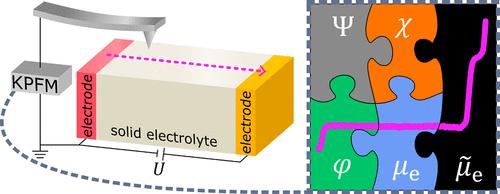固态电化学电池中开尔文探针力测量的解释
IF 8.2
2区 材料科学
Q1 MATERIALS SCIENCE, MULTIDISCIPLINARY
引用次数: 0
摘要
开尔文探针力显微镜(KPFM)提供了平衡条件下电子导体功函数的可靠测量方法。KPFM较少使用但用途广泛的应用是电化学装置在运行中的表征,即非平衡条件下的装置。我们从伏特电位及其与表面电位、电子化学势、伽瓦尼势和功函数的关系的基本考虑出发,推导出KPFM信号的解释。作为理解电化学电池中operando测量的关键实验,我们研究了用混合离子-电子导体(MIEC)构建的Hebb-Wagner固态极化电池(HWC)。使用基于非晶Li3PO4的模型型MIEC,我们说明了电化学中使用的不同电位如何影响KPFM信号。我们表明,一旦特定假设成立,KPFM测量值对应于沿HWC的内部电(Galvani)电位分布。因此,KPFM在研究运行中的电化学电池中的固体电解质方面非常有价值。这种电池是全固态电池的合适模型,是未来高能量密度电池的候选者。本文章由计算机程序翻译,如有差异,请以英文原文为准。

Interpretation of Kelvin Probe Force Measurements in Solid-State Electrochemical Cells
Kelvin probe force microscopy (KPFM) provides an established and reliable measurement of the work function of electronic conductors under equilibrium conditions. A less used but highly versatile application of KPFM is the characterization of electrochemical devices in operation, i.e., devices under nonequilibrium conditions. We derive the KPFM signal interpretation from basic considerations of the Volta potential and its relation to the surface potential, chemical potential of electrons, Galvani potential, and work function. As a key experiment for understanding operando measurements at electrochemical cells, we investigate a Hebb–Wagner solid-state polarization cell (HWC), constructed with a mixed ionic-electronic conductor (MIEC). Using a model-type MIEC based on amorphous Li3PO4, we illustrate how different potentials used in electrochemistry contribute to the KPFM signal. We show that KPFM measurements correspond to the inner electric (Galvani) potential profile along the HWC, once specific assumptions are valid. Consequently, KPFM can be very valuable in the investigation of solid electrolytes in operating electrochemical cells. Such cells are suitable models for all-solid-state batteries, candidates for future high energy density batteries.
求助全文
通过发布文献求助,成功后即可免费获取论文全文。
去求助
来源期刊

ACS Applied Materials & Interfaces
工程技术-材料科学:综合
CiteScore
16.00
自引率
6.30%
发文量
4978
审稿时长
1.8 months
期刊介绍:
ACS Applied Materials & Interfaces is a leading interdisciplinary journal that brings together chemists, engineers, physicists, and biologists to explore the development and utilization of newly-discovered materials and interfacial processes for specific applications. Our journal has experienced remarkable growth since its establishment in 2009, both in terms of the number of articles published and the impact of the research showcased. We are proud to foster a truly global community, with the majority of published articles originating from outside the United States, reflecting the rapid growth of applied research worldwide.
 求助内容:
求助内容: 应助结果提醒方式:
应助结果提醒方式:


